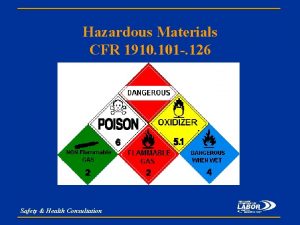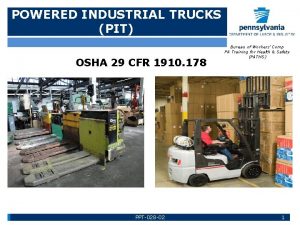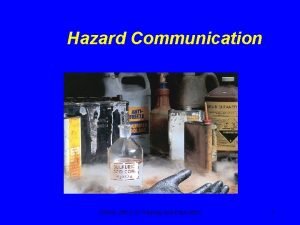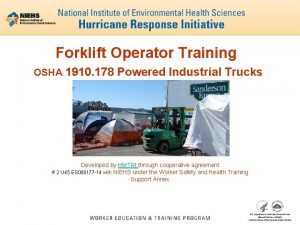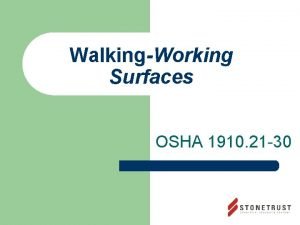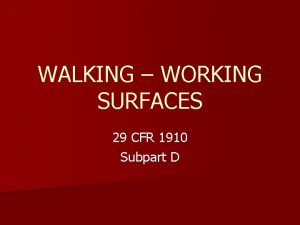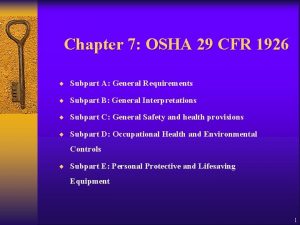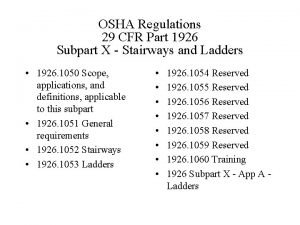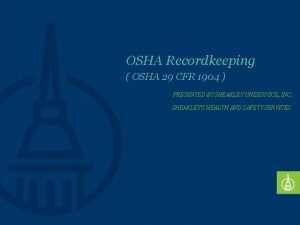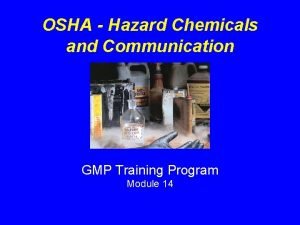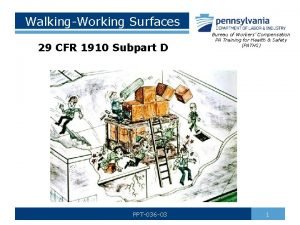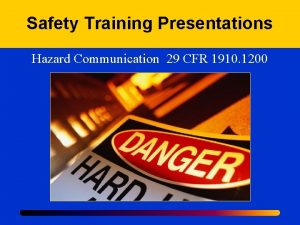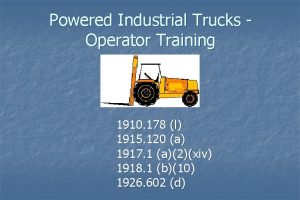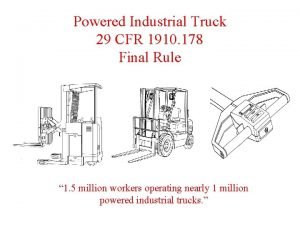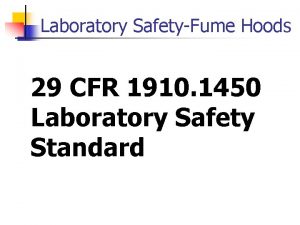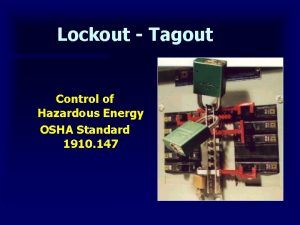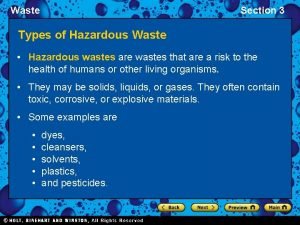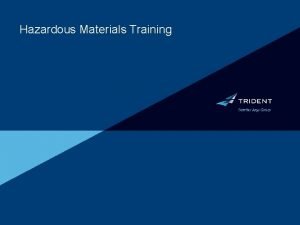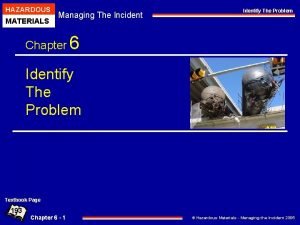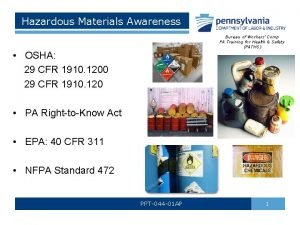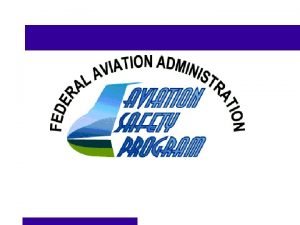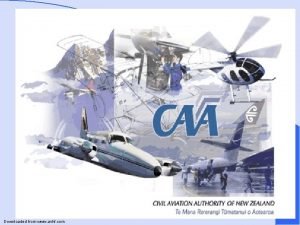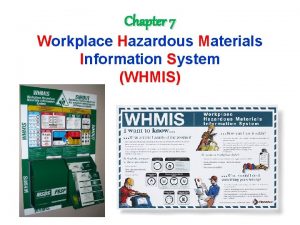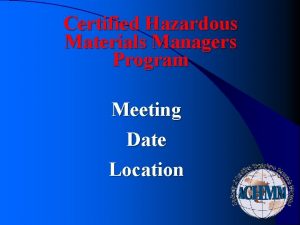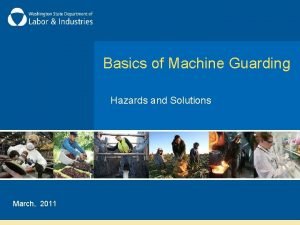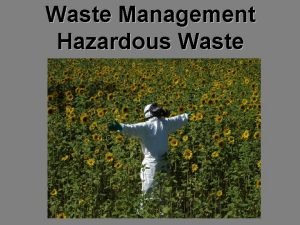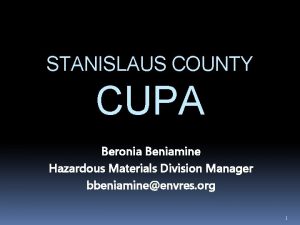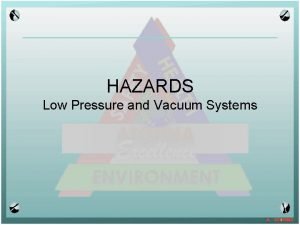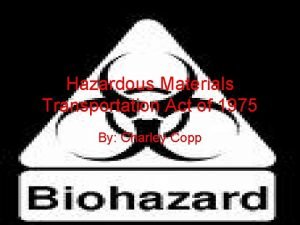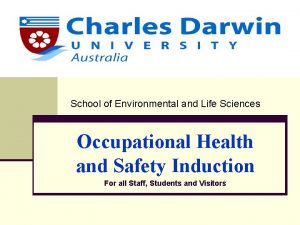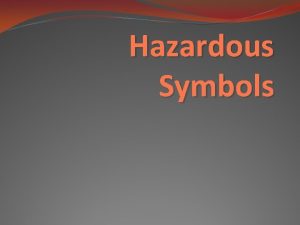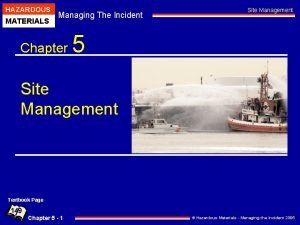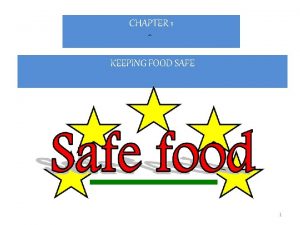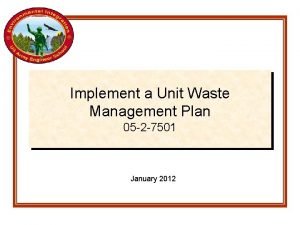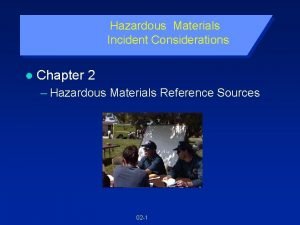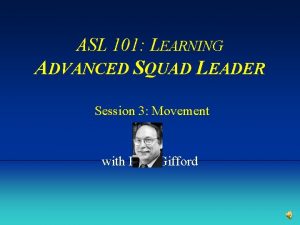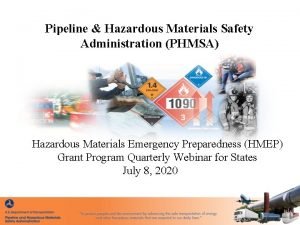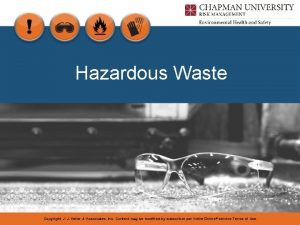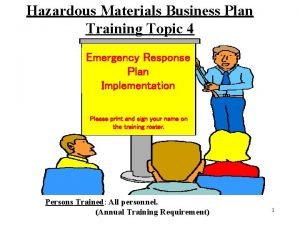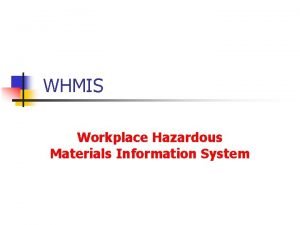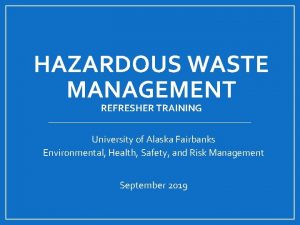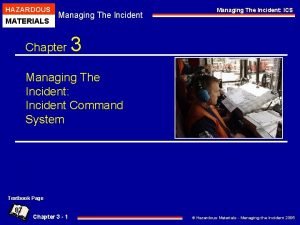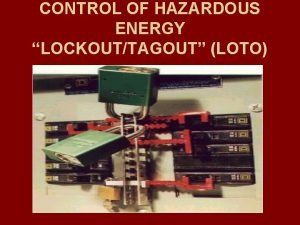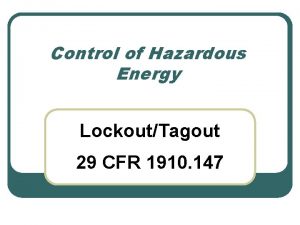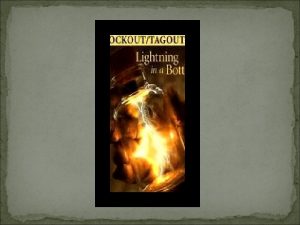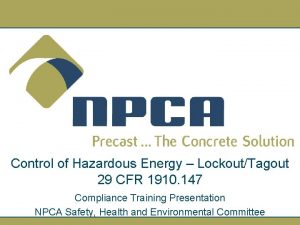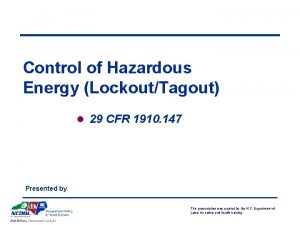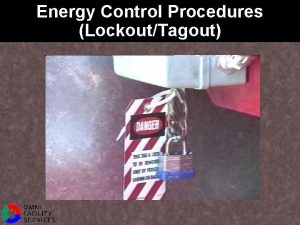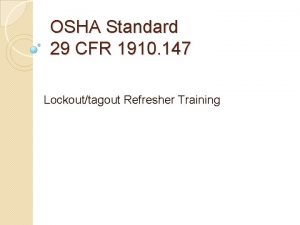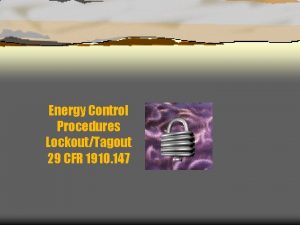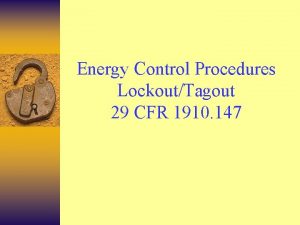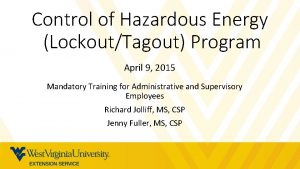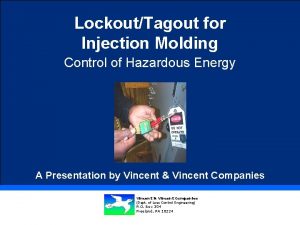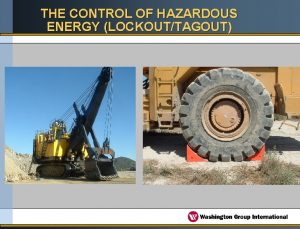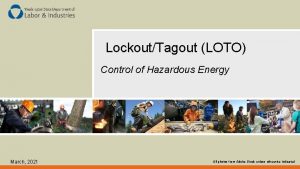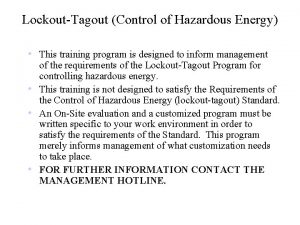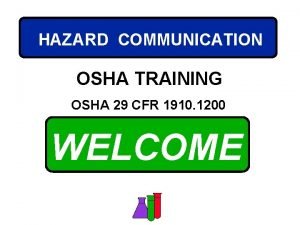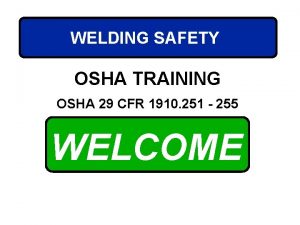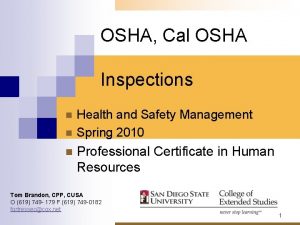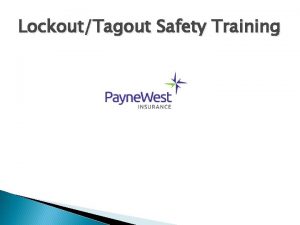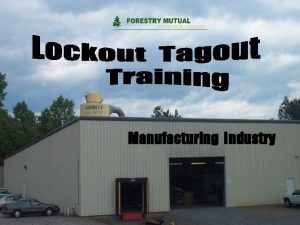CONTROL OF HAZARDOUS ENERGY LOCKOUTTAGOUT OSHA 29 CFR
























































- Slides: 56

CONTROL OF HAZARDOUS ENERGY LOCKOUT/TAGOUT OSHA 29 CFR 1910. 147 WELCOME

COURSE OBJECTIVES þ Teach The Student to Recognize Where Lockout/Tagout Is Needed. þ Allow the Student to Develop an Understanding of the Local Lockout/Tagout Policy. þ Introduce Techniques Needed to Select the Appropriate Lockout/Tagout Devices. þ Teach the Student to Successfully Conduct Lockout/Tagout Operations. þ Introduce the Rules for Safe Lockout/Tagout.

REGULATORY STANDARD CONTROL OF HAZARDOUS ENERGY 29 CFR - 1910 - 147 29 CFR - Safety and Health Standards 1910 - General Industry 147 - Lockout Tagout Standard

REGULATORY STANDARD 29 CFR 1910. 147 þ Title - Control of Hazardous Energy þ September 1, 1989 - Final Rule Issued þ January 2, 1990 - Final Rule Took Effect

CIRCUMSTANCES OF INJURY HOW MOST INJURIES OCCUR IN ORDER OF OCCURRENCE þ þ Injured by Moving Machinery Part. Made Contact With Energized Part. Injured by Physical Hazard (Heat, Chemicals). Injured by Falling Machine Part.

CIRCUMSTANCES OF INJURY ACTIVITY AT TIME OF ACCIDENT FREQUENCY OF OCCURRENCE 1. 2. 3. 4. 5. Unjamming Object(S) From Equipment Cleaning Equipment Repairing Equipment Performing Routine Maintenance Installing Equipment

CIRCUMSTANCES OF INJURY ACTIVITY AT TIME OF ACCIDENT FREQUENCY OF OCCURRENCE 6. Adjusting Equipment 7. Doing Set-up Work 8. Performing Electrical Work 9. Inspecting Equipment 10. Testing Materials

CIRCUMSTANCES OF INJURY REASONS FOR EQUIPMENT NOT BEING TURNED OFF þ þ þ þ Afraid of Slow Down in Production. ON OFF Afraid It Would Take Too Long. Not Required by Company Procedure. Worker Didn't Know Power Was on. SYSTEM Worker Didn't Know How to Turn Off. CONTROL SWITCH Did Not Think It Was Necessary. Task Could Not Be Done With Power Off.

CIRCUMSTANCES OF INJURY REASONS FOR EQUIPMENT BEING TURNED ON þ þ þ Accidentally Turned on by Injured Employee Co-Worker Accidentally Turned Equipment On Equipment Moved When Jam-up Cleared ON Equipment Unexpectedly "Cycled" Parts Still in Motion (Coasting) OFF SYSTEM CONTROL SWITCH

CASE STUDY #1 KILLED BY THE MOVING PARTS OF A SAW Narrative: An Employee Was Cleaning the Unguarded Side of an Operating Granite Saw. The Employee Was Caught in the Moving Parts Of The Saw and Pulled Into a Nip Point Between The Saw Blade and the Idler Wheel, Resulting In Fatal Injuries. Citation: Failure to Shutdown or Turn off Equipment To Perform Maintenance.

CASE STUDY #2 DECAPITATED BY SHEARING MACHINE Narrative: An Employee Was Removing Scrap From Beneath a Large Shear When a Fellow Employee Hit the Control Button Activating The Blade Cycled and Decapitated The Employee Cleaning Scrap. Citation: Failure to Shutdown or Turn off Equipment To Perform Maintenance.

CASE STUDY #3 KILLED BY PNEUMATIC DOOR Narrative: An Employee Was Partially Inside of an Asphalt Mixing Machine Changing Its Paddles. Another Employee, While Dusting in The Control Room, Accidentally Hit a Toggle Switch Which Caused the Door of the Mixer to Close, Striking the First Employee on the Head and Killing Him. Citation: Failure to Isolate Equipment From Energy Sources Before Attempting Any Repair, Maintenance or Servicing.

DEFINITION OF EMPLOYEES þ Authorized Employee The Person Who Locks or Tags Out Machines To Perform Servicing or Maintenance. þ Affected Employee An Employee Whose Job Requires Him or Her To Operate or Use a Machine or Piece of Equipment On Which Servicing or Maintenance Is Being Performed.

DEFINITION OF EMPLOYEES þ Designated Inspector @ Does Not Utilize the Specific Procedure. @ The Person Who Inspects the LO/TO Procedure. @ Is an Authorized Employee.

TRAINING REQUIREMENTS þ Authorized Employee ü Recognition of Hazardous Energy Sources. ü Type and Magnitude Energy Sources. ü Energy Isolation and Control Methods.

TRAINING REQUIREMENTS þ Affected Employee ü Purpose and Use of The Energy Control Program.

TRAINING REQUIREMENTS þ All Other Employees ü Procedures and Prohibitions Relating To Attempts to Restart or Reenergize Machines or Equipment Which Are Locked Out or Tagged Out. .

RETRAINING REQUIREMENTS Authorized and Affected Employees Retraining Provided When There Is a: þ Change in Job Assignment. þ Change in Machines, Equipment or Processes. þ Change in Energy Control Procedures. þ Close-Call Event. þ Failure in the Procedures. þ Reason to Doubt Employee Proficiency.

ENERGY CONTROL PROGRAM þ THREE ELEMENTS TO THE PROGRAM: 1. ENERGY CONTROL PROCEDURES 2. EMPLOYEE TRAINING 3. PERIODIC INSPECTIONS

DEFINITION OF LOCKOUT Lockout Is Defined as: The Placement of a Lockout Device on an Energy Isolating Device, in Accordance With an Established Procedure, Ensuring That the Energy Isolating Device and the Equipment Being Controlled Cannot Be Operated Until the Lockout Device Is Removed.

DEFINITION OF ENERGY ISOLATING DEVICE þ þ þ Block Line Valve Disconnecting Switch Manually Operated Switch Any Other Device That Isolates Energy

TYPES OF ENERGY SOURCES þ HYDRAULIC þ PNEUMATIC þ MECHANICAL þ RADIOACTIVE þ THERMAL þ ELECTRICAL þ CHEMICAL

TYPES OF ENERGY STATES ACTIVE ENERGY 110 VOLTS AC STORED ENERGY HOT SURFACE

TYPES OF ENERGY STATES ACTIVE ENERGY þ VOLTAGES þ EXTERNAL PRESSURIZED LINE FEEDS TO THE MACHINE

TYPES OF ENERGY STATES STORED ENERGY þ þ þ þ INTERNAL LINE PRESSURES CAPACITORS SURFACE TEMPERATURES MECHANICAL TENSION (SPRINGS, ETC. ) COASTING OF PARTS CHEMICAL (OPPOSING p. H) GRAVITY

THE SCOPE OF LOCKOUT/TAGOUT AREAS REGULATED BY 29 CFR 1910. 147: þ SERVICING OF MACHINES AND EQUIPMENT þ MAINTENANCE OF MACHINES AND EQUIPMENT AREAS NOT REGULATED: þ þ CONSTRUCTION, AGRICULTURE AND MARITIME WORK CONTROLLED BY ELECTRIC UTILITIES ELECTRIC UTILITY INSTALLATIONS OIL AND GAS WELL DRILLING AND SERVICING

ACTIVITIES COVERED þ NORMAL OPERATIONS: 1. Covered If an Employee Must Remove or Bypass Guards or Devices 2. Covered Where Employees Are Required to Put A Body Part in a Machine Process Area 3. Covered Where Employees Are Required to Put A Body Part in a Machine Having a Danger Zone

TAGOUT REQUIREMENTS DANGER LOCKED OUT DO NOT OPERATE This Lock/Tag may only be removed by NAME: ________ DEPT : ________ EXPECTED COMPLETION DATE: ________ TIME: _________

REQUIREMENTS IF TAGOUT IS USED þ SOME KEY POINTS ABOUT TAGS: ü ü ü ü DANGER Tags Are Only Warning Devices! LOCKED OUT Tags Must Be Securely Attached! May Evoke False Sense of Security! Tags Do Not Provide Physical Restraint! Tags Must Never Be Defeated or Ignored! Must Withstand Environmental Conditions! Tags Must Be Legible and Understandable! Tags Are Only Removed by the Responsible Person. DO NOT OPERATE This Lock/Tag may only be removed by NAME: ________ DEPT : ________ EXPECTED COMPLETION DATE: ________ TIME: _________

LOCK OUT SEQUENCE OF EVENTS 1. 2. 3. 4. 5. 6. 7. 8. 9. Preparation for Shutdown Machine or Equipment Isolation Application of Lockout/Tagout Devices Testing of LO/TO Servicing or Maintenance Removal of LO/TO Devices Reenergization Equipment Reactivation DANGER LOCKED OUT DO NOT OPERATE This Lock/Tag may only be removed by NAME: ________ DEPT : ________ EXPECTED COMPLETION DATE: ________ TIME: _________

WRITTEN PROGRAM REQUIREMENTS ALL EMPLOYERS MUST: þ þ þ Maintain a Written Program. Review the Program on an Annual Basis. Develop Detailed Energy Control Procedures. Review Individual LO/TO Procedures Annually. Make the Written Program Available to All Affected Employees During Each Work Shift.

ENERGY CONTROL PROCEDURES 29 CFR 1910. 147 REQUIRES THAT: Procedures Be Developed, Documented and Utilized for Control of Potentially Hazardous Energy When Employees Are Engaged in the Activities Covered by the Standard.

ENERGY CONTROL PROCEDURES MUST CONTAIN: 1. 2. 3. 4. Statement of Intended Use. Steps for Shut-Down and Energy Control. Steps for LO/TO Device Placement, Transfer and Removal. Determination of Responsibility. 5. Steps for Testing LO/TO.

EXCEPTIONS TO THE REQUIREMENT TO HAVE WRITTEN LOTO PROCEDURES ALL OF THE FOLLOWING EIGHT CONDITIONS MUST EXIST: 1. No Potential for Residual, Stored or Reaccumulation of Energy. 2. Contains Only One Energy Source Which Is Readily Identified and Isolated. 3. Isolating & Locking Out Results in Complete De-Energization. 4. The Machine or Equipment Is Isolated or Locked Out During Maintenance. 5. One Lockout Device Will Achieve Complete Lockout.

EXCEPTIONS TO THE REQUIREMENT TO HAVE WRITTEN LOTO PROCEDURES ALL OF THE FOLLOWING EIGHT CONDITIONS MUST EXIST: 6. The Lockout Device Is Under Exclusive Control Of An Authorized Employee 7. Servicing/Maintenance Does Not Produce Hazards For Other Employees 8. No Previous Energy Control Accident History Exists for the Employer

ENERGY CONTROL PROCEDURES þ PROCEDURES INSPECTED ANNUALLY þ INSPECTIONS PERFORMED BY “AUTHORIZED EMPLOYEES” OTHER THAN PRIMARY þ LOCKOUT REVIEWED BETWEEN INSPECTOR AND AUTHORIZED EMPLOYEES þ TAGOUT REVIEWED BETWEEN INSPECTOR AND AUTHORIZED/AFFECTED EMPLOYEES

ENERGY CONTROL PROCEDURES ANNUAL INSPECTIONS MUST INCLUDE: þ DATE OF INSPECTION þ IDENTIFICATION OF MACHINE OR EQUIPMENT þ EMPLOYEES INCLUDED IN INSPECTION þ PERSON PERFORMING INSPECTION

RELEASE FROM LOCKOUT/TAGOUT THE AUTHORIZED EMPLOYEE MUST: 1. INSPECT WORK AREA FOR HAZARDS 2. CLEAR ALL EMPLOYEES 3. NOTIFY ALL AFFECTED EMPLOYEES 4. REMOVE ENERGY ISOLATING DEVICES

IMPORTANT POINTS TO REMEMBER þ WHERE LOCKOUT CAN BE USED: IT MUST BE* þ WHERE LOCKOUT CANNOT BE USED: TAGOUT PROCEDURES MUST BE INITIATED *(Unless It Can Be Demonstrated That Full Protection Can Be Achieved by Other Means)

GROUP LOCKOUT/TAGOUT þ FOUR SPECIFIC REQUIREMENTS 1. Responsibility Vested in a Single Authorized Employee. 2. The Authorized Employee Must Have the Authority To Determine Exposure Status of Group Members. 3. With Multiple Crews the Authorized Employee Must Be Assigned the Responsibility of The Overall Job. 4. The Authorized Employee Shall Affix an Individual LO/TO Device at the Beginning of Work and Remove It at Completion of the Work.

GROUP LOCKOUT/TAGOUT WHEN THE AUTHORIZED EMPLOYEE IS UNAVAILABLE þ PROCEDURES MUST INCLUDE, AS A MINIMUM: 1. Proof That the Employee Who Applied the Device Is Unavailable. 2. A Valid Attempt to Inform the Employee Who Applied the Device, That It Has Been Removed. 3. Adequate Notice to the Employee Who Applied The Device, of the Removal of the Device Before That Employee Returns to Work.

CONTRACTOR SAFETY REQUIREMENTS OUTSIDE CONTRACTORS MUST: þ Inform Representatives of the Facility Of Their LO/TO Procedures and Devices. COMPANY REPRESENTATIVES MUST: þ Inform the Contractor of Internal LO/TO Procedures and Devices. þ Ensure That the Contractor(S) Are Following LOTO Procedures.

TIPS FOR USING CONTRACTORS þ þ þ Remember, You Control Your Facility! Review Their Procedures With Them Before Starting the Job! Determine Their Safety Performance Record! Determine Who Is in Charge of Their People! Determine How They Will Affect Your Employees! Ensure Your Data on Your Facility Is Accurate!

KEY ELEMENTS TO AN EFFECTIVE PROGRAM 1. 2. 3. 4. Develop and Strictly Adhere to LO/TO Procedures. Establish and Enforce Safe Work Practices. Ensure Proper Training and Supervision. Strengthen and Modify Present Policies. 5. Understand the Relationship Between 29 CFR 1910. 147 And the Business or Industry Involved.

EQUIPMENT REQUIREMENTS DEVICES AND TAGS MUST BE: 1. 2. 3. 4. Durable Standardized Identifiable Substantial DEVICES AND TAGS ARE: 1. Designed to Prevent Accidental Energization. 2. Not Designed As a Substitution for Security.

CASE STUDY #1 WORKER KILLED BY MIXING MACHINE NARRATIVE: An employee was assigned the task of cleaning the inside of a sand mixer. The task was conducted during a break in the production cycle, caused by routine maintenance work. He did this without anyone else’s knowledge. While he was engaged in this, out of sight and hearing of the others, an electrician started the machine, killing the man inside. This plant had a written lockout procedure, training had been given, and all affected employees (including the deceased), were issued keys and locks.

QUESTIONS TO BE CONSIDERED þ þ þ þ þ What caused the death of the worker? DANGER Do you believe there are multiple causes? LOCKED OUT Are multiple OSHA Standard violations involved? What could upper management have done? What could the supervisor have done? What could the co-workers have done? To what extent was attitude responsible? To what extent is a lack of written policy responsible? To what extent is a lack of training responsible? Do you believe there is a single cause to this accident that, if removed would have prevented it? DO NOT OPERATE This Lock/Tag may only be removed by NAME: ________ DEPT : ________ EXPECTED COMPLETION DATE: ________ TIME: _________

CASE STUDY #2 WORKER KILLED BY HIGH VOLTAGE NARRATIVE: A 13, 800 -volt main circuit breaker was under routine inspection. A test instrument was used to check for electrical energy. No electrical energy was detected at the primary power contacts in the circuit breaker. To verify the operation of the tester, the sensitivity was readjusted and checked against a known 120 -volt receptacle. The tester was found to be operable. As the journeyman electrician approached one of the contacts with a shop towel, an explosion, engulfed him in flames. The power from the public utility company to the main circuit breaker had not been shut off.

QUESTIONS TO BE CONSIDERED þ þ þ þ þ What caused the death of the worker? DANGER Do you believe there are multiple causes? LOCKED Are multiple OSHA Standard violations involved? OUT What could upper management have done? What could the supervisor have done? What could the co-workers have done? To what extent was attitude responsible? To what extent is a lack of written policy responsible? To what extent is a lack of training responsible? Do you believe there is a single cause to this accident that, if removed would have prevented it? DO NOT OPERATE This Lock/Tag may only be removed by NAME: ________ DEPT : ________ EXPECTED COMPLETION DATE: ________ TIME: _________

CASE STUDY #3 WORKER KILLED BY STORAGE MECHANISM NARRATIVE: A stock handler entered a computer controlled storage and retrieval area apparently to perform stock inventory. While performing this work he was crushed between the robot retrieval vehicle and a third level post, when the vehicle responded to an electronic command. It was found that even though there were a number of disconnect switches on the vehicle and main console none had been used. The plant had no written lockout procedure and workers had not been trained or advised regarding entry into this area.

QUESTIONS TO BE CONSIDERED þ þ þ þ þ What caused the death of the worker? DANGER Do you believe there are multiple causes? LOCKED Are multiple OSHA Standard violations involved? OUT What could upper management have done? What could the supervisor have done? What could the co-workers have done? To what extent was attitude responsible? To what extent is a lack of written policy responsible? To what extent is a lack of training responsible? Do you believe there is a single cause to this accident that, if removed would have prevented it? DO NOT OPERATE This Lock/Tag may only be removed by NAME: ________ DEPT : ________ EXPECTED COMPLETION DATE: ________ TIME: _________

CASE STUDY #4 WORKER KILLED BY PARTS UNLOADER NARRATIVE: The part presence switch to an unloading fixture was sticking on an automatic transfer line. The jobsetter removed a guard and was standing at the side of the line to observe the operation of the switch. He apparently leaned forward just as the unloader actuated; it caught his right side and crushed him between the moving unloader and the support post for the guard. The company had a written lockout program and the employee had attended operator awareness training for control of hazardous energy.

QUESTIONS TO BE CONSIDERED þ þ þ þ þ What caused the death of the worker? DANGER Do you believe there are multiple causes? LOCKED Are multiple OSHA Standard violations involved? OUT What could upper management have done? What could the supervisor have done? What could the co-workers have done? To what extent was attitude responsible? To what extent is a lack of written policy responsible? To what extent is a lack of training responsible? Do you believe there is a single cause to this accident that, if removed would have prevented it? DO NOT OPERATE This Lock/Tag may only be removed by NAME: ________ DEPT : ________ EXPECTED COMPLETION DATE: ________ TIME: _________

CASE STUDY #5 DECAPITATED BY SHEARING MACHINE NARRATIVE: An employee was removing scrap from beneath a large shear when a fellow employee hit the control button activating The blade cycled and decapitated the employee cleaning scrap. The company had no written lockout procedure and workers had not been trained or advised regarding the hazards associated with machinery.

QUESTIONS TO BE CONSIDERED þ þ þ þ þ What caused the death of the worker? DANGER Do you believe there are multiple causes? LOCKED Are multiple OSHA Standard violations involved? OUT What could upper management have done? What could the supervisor have done? What could the co-workers have done? To what extent was attitude responsible? To what extent is a lack of written policy responsible? To what extent is a lack of training responsible? Do you believe there is a single cause to this accident that, if removed would have prevented it? DO NOT OPERATE This Lock/Tag may only be removed by NAME: ________ DEPT : ________ EXPECTED COMPLETION DATE: ________ TIME: _________

ENERGY CONTROL PROGRAM REVIEW þ THREE ELEMENTS TO THE PROGRAM: 1. ENERGY CONTROL PROCEDURES 2. EMPLOYEE TRAINING 3. PERIODIC INSPECTIONS
 Compressed gas association pamphlet p-1-1965
Compressed gas association pamphlet p-1-1965 Osha 1910 powered industrial trucks
Osha 1910 powered industrial trucks Osha cfr 1910 is the standard for______.
Osha cfr 1910 is the standard for______. 29 cfr 1910 osha 178
29 cfr 1910 osha 178 Osha ladders 1910
Osha ladders 1910 1910 subpart d
1910 subpart d Osha 29 cfr 1910 1200
Osha 29 cfr 1910 1200 A double cleated ladder should be provided
A double cleated ladder should be provided Osha 29 cfr 1904
Osha 29 cfr 1904 Osha hazard and ghs training regulation cfr 1910
Osha hazard and ghs training regulation cfr 1910 Ppt-036
Ppt-036 29 cfr 1910 osha 178
29 cfr 1910 osha 178 29 cfr 1910 osha 178
29 cfr 1910 osha 178 29cfr1910.178
29cfr1910.178 29 cfr 1910 osha 178
29 cfr 1910 osha 178 29 cfr1910.1200
29 cfr1910.1200 Hazard communication 29 cfr 1910
Hazard communication 29 cfr 1910 Hazardous energy
Hazardous energy Energy energy transfer and general energy analysis
Energy energy transfer and general energy analysis Energy energy transfer and general energy analysis
Energy energy transfer and general energy analysis Section 3 hazardous waste answers
Section 3 hazardous waste answers Aviation hazardous attitudes
Aviation hazardous attitudes Definition of biomedical waste management
Definition of biomedical waste management Dot
Dot Hazardous materials table
Hazardous materials table Hazardous
Hazardous Hazwoper
Hazwoper Five hazardous attitudes
Five hazardous attitudes 5 hazardous attitudes
5 hazardous attitudes Shape and color of whmis 2015 symbols
Shape and color of whmis 2015 symbols Certified hazardous materials manager
Certified hazardous materials manager What's the guarding hazard in the image?
What's the guarding hazard in the image? Hazardous waste apes
Hazardous waste apes Sample of hazardous waste
Sample of hazardous waste Stanislaus county hazardous waste
Stanislaus county hazardous waste Nj crtk environmental hazardous substances
Nj crtk environmental hazardous substances Vacuum hazards
Vacuum hazards Hazardous materials transportation act of 1975
Hazardous materials transportation act of 1975 Hazardous area training darwin
Hazardous area training darwin Hazardous symbols
Hazardous symbols Hazardous materials managing the incident
Hazardous materials managing the incident Keeping food safe chapter 1
Keeping food safe chapter 1 Hazardous drug api
Hazardous drug api On july 18 2001 a train carrying hazardous chemicals
On july 18 2001 a train carrying hazardous chemicals Waste management references
Waste management references Hazardous materials reference books
Hazardous materials reference books Hazardous area response team
Hazardous area response team Hazardous movement asl
Hazardous movement asl Solid and hazardous waste
Solid and hazardous waste Pipeline and hazardous materials administration
Pipeline and hazardous materials administration Noaa experimental forecast
Noaa experimental forecast Hazardous waste transportation
Hazardous waste transportation Hazardous materials incident report
Hazardous materials incident report Hazardous materials business plan
Hazardous materials business plan Whmis r with test tube
Whmis r with test tube Alaska hazmat training
Alaska hazmat training Hazardous materials managing the incident
Hazardous materials managing the incident
